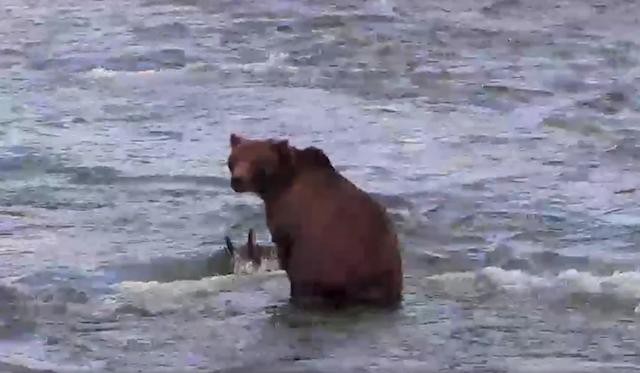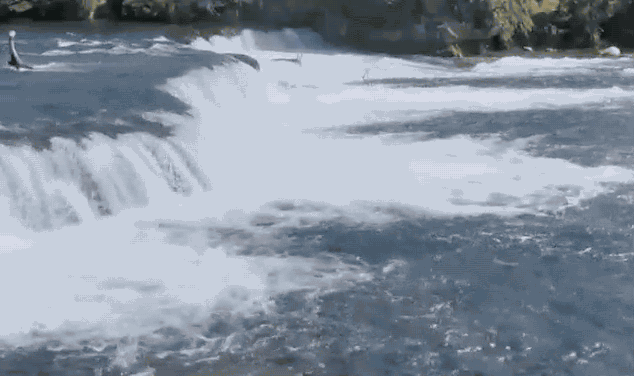Life and Death on the Bear Cam
Life and Death on the Bear Cam

The bear cams are back: Feeds from Katmai National Park in Alaska are going live this week. Some are powered up already and in testing; others are still coming online. The bear cams have become an odd yearly ritual for the nature-obsessed and vocationally computer-bound alike, developing an avid fan base that tracks the comings and goings of dozens upon dozens of feeding bears. Each year the cameras get better, their hours longer, and their stories richer.
So what will happen in 2014? What are we in for? I called Roy Wood, Chief of Interpretation for Katmai National Park, who helps run the cams. He told me a story from a few years back.
First year, toward the end of the season, there was a story arc, if you will. A thing called a bear cache, or a kill cache — when bears kill something larger than they can eat in one sitting, like a moose or a caribou, they pile up a bunch of debris on it. Grass, leaves, dirt. Then they sort of camp out by it, until they’ve eaten it all or grown tired of the leftovers, and then they move on to something else.
A cache appeared one morning. In October the hours are pretty short. We still have long days, but the solar intensity was such that we couldn’t keep the cams running all day, so they were running from about eleven in the morning and going off at about four. So, at eleven o’clock the cam comes live on this beautiful weekend, and there’s this big pile of grass and dirt directly in front of it. There’s a bear sitting on top. Most people have never heard of [a bear cache], or seen it; even people that work around bears all the time don’t have such a great view of kill caches, because you don’t want to get anywhere near them. That’s one of the most dangerous situations you can find yourself in.
But here it was, smack dab in front of the camera. And this is a bear we didn’t see very often. Luckily, this bear had a diamond patch of much lighter fur on its side, so it’s very easy to pick out. It’s one we didn’t see that often because he’s very shy around people; he really doesn’t show up until most of are gone from the camp.
So he’s on this cache, and we don’t know what’s in it. He never pulls anything out and eats it while we’re there. The camera goes dead at four o’clock.
Then, next morning, the cache is twice the size, and there’s a different bear on top. Much larger. A bear that’s been known to kill other bears. So now there’s this mystery — did Lurch, the new bear, kill this other bear? Is he now buried in the cache too? Of course the camera goes dead before we know what’s happened.
We’re off for the holiday weekend, and I get back to the office. I talk to a few people who are out at the camp and they say, yes, it’s definitely a bear in there.
I power up the cameras so I can take a peek around, and see what’s going on before the cameras go live. I see a bear’s foot sticking out of the cache.

Wood, looking forward, is excited. “From the time the cams go live until they end, there’s always something going on,” he says. He expects a good year, but that’s about as specific as he can get. His story continues:
We tell the operators not to zoom in too far, you know, not to make people sick. But this is a rare opportunity to see nature uncensored, as it actually happens out there. And it’s a wonderful scientific opportunity, because we couldn’t get that close to the cache if we were out there.
You can imagine that when we found out it’s not a moose, it’s not a caribou, that people were very upset about it. They were upset with Lurch, and they were worried about the safety of all the other bears. They didn’t like Lurch already, because they knew about his behavior in the past. Some of these people had seen footage of him killing a cub in 2006, a cub from one of everybody’s favorite bears.
People knew about his habits. Immediately people start assuming he had killed this other bear, which they had started calling Patches, and the conversation was around: When is the park service going to take care of the problem? Because he’s a murderer, a serial killer, a threat.
These were human-value-laden words. So I’m on the cameras, engaging people with this. I’m not telling them they’re wrong, but I’m trying to tell them to think from a bear’s perspective. Protein is protein. This kill virtually ensures his ability to get through the winter.
By the end of the week, I was so proud of the people on these cams, because they went from complete horror and disgust and disdain for this animal to using words like “power” and “strength” and “survival” and “tenacity.” And that’s exactly, sort of, the goal here — to get people to have respect, and a deeper understanding.
Bear cams, man, they change you. Here are the links for this year:
— Brooks Falls
— Lower River
— River Watch
— The Riffles
What ever happened to Lurch, anyway?
The last time he was seen was right at the time of the government shutdown. He was not seen on the camera, but by people who were packing up after they were told they needed to get up and get out of there. He had killed another bear; it’s something he does frequently. He had another bear buried in a food cache near the campground. That’s the last any of us have seen of him.
Eyes peeled.
